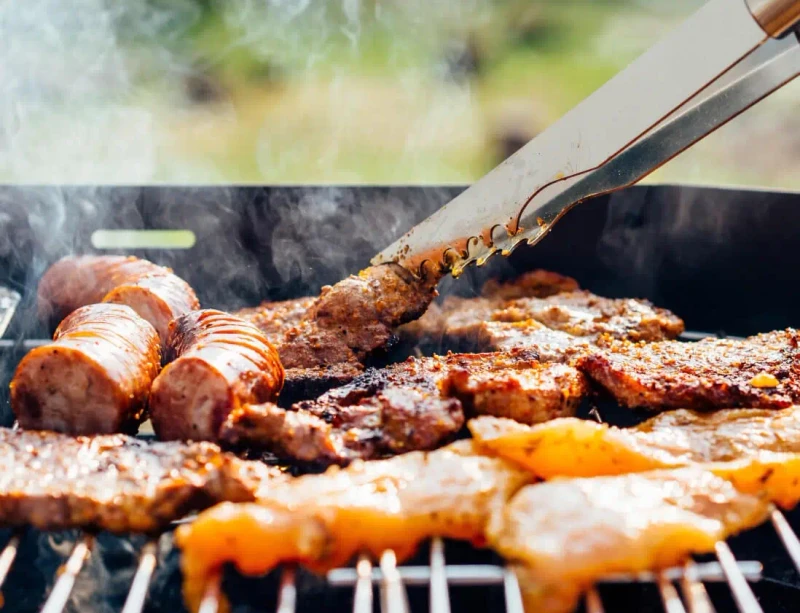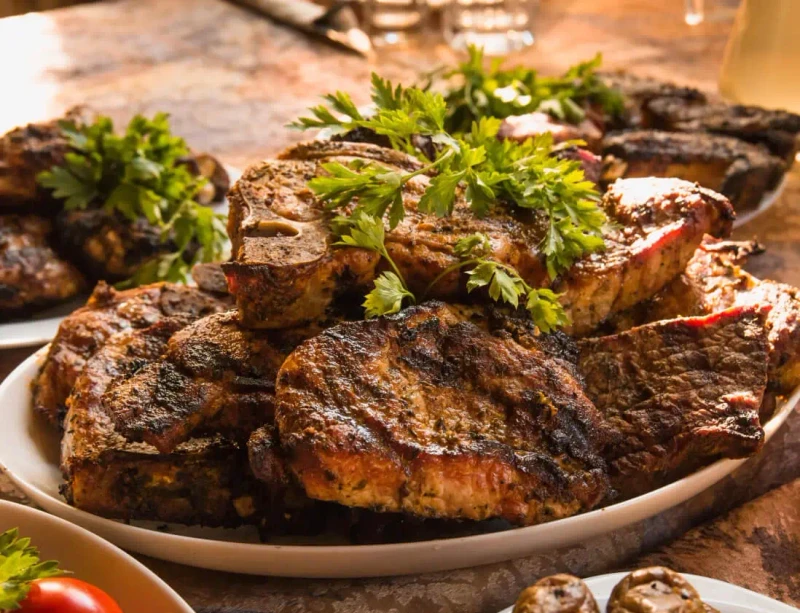Pork: Calories
| Food | Serving | Calories | Serving | Calories |
|---|---|---|---|---|
Bacon | 100 g | 270 Cal | 100 g | 81 Cal |
Baked Ham | 100 g | 135 Cal | 100 g | 28 Cal |
Cumberland Sausage | 100 g | 325 Cal | 100 g | 244 Cal |
Ground Pork | 100 g | 279 Cal | 100 g | 557 Cal |
Hog Maws | 100 g | 250 Cal | 100 g | 250 Cal |
Pork | 100 g | 279 Cal | 100 g | 557 Cal |
Pork Bacon | 100 g | 810 Cal | 100 g | 607 Cal |
Pork Belly | 100 g | 197 Cal | 100 g | 493 Cal |
Pork Chop | 100 g | 133 Cal | 100 g | 113 Cal |
Pork Chop, grilled | 100 g | 150 Cal | 100 g | 450 Cal |
Pork Country Style Ribs | 100 g | 189 Cal | 100 g | 242 Cal |
Pork Cutlet | 100 g | 106 Cal | 100 g | 132 Cal |
Pork Egg Roll | 100 g | 278 Cal | 100 g | 178 Cal |
Pork Leg | 100 g | 179 Cal | 100 g | 447 Cal |
Pork Liver | 100 g | 129 Cal | 100 g | 36 Cal |
Pork Loin | 100 g | 106 Cal | 100 g | 120 Cal |
Pork Roast | 100 g | 296 Cal | 100 g | 741 Cal |
Pork Roll | 100 g | 106 Cal | 100 g | 79 Cal |
Pork Sausage | 100 g | 293 Cal | 100 g | 146 Cal |
Pork Shoulder | 100 g | 219 Cal | 100 g | 546 Cal |
Pork Skin | 100 g | 621 Cal | 100 g | 311 Cal |
Pork Spare Ribs | 100 g | 277 Cal | 100 g | 310 Cal |
Pork Steak | 100 g | 106 Cal | 100 g | 95 Cal |
Pork Tamale | 100 g | 174 Cal | 100 g | 247 Cal |
Pork Tongue | 100 g | 160 Cal | 100 g | 192 Cal |
Salt Pork | 100 g | 184 Cal | 100 g | 52 Cal |
Sausage Patty | 100 g | 288 Cal | 100 g | 72 Cal |
Slice of Ham | 100 g | 97 Cal | 100 g | 16 Cal |
Smoked Sausage | 100 g | 309 Cal | 100 g | 210 Cal |
Spare Ribs, Pork Ribs | 100 g | 320 Cal | 100 g | 768 Cal |
Incorporating Pork into a Healthy Diet
Enjoyed by many cultures around the world and avoided by others, there’s no doubting the versatility of this meat. Transformed into products such as lard, bacon, pancetta, pork belly, pork chops and sausages, if eaten in moderation, pork can provide several benefits to your diet. Pork can provide the body with minerals such as iron and zinc. It also tends to be lower in calories than other meat options, such as beef. How pork is prepared, the cut and the level of processing, however, can all play a significant factor in the caloric impact of pork products.
To reduce your caloric intake when it comes to pork, opt for lean cuts and be sure to trim any excess fat off of the meat. You should also bake or boil the meat instead of frying or breading it. Using a non-stick pan can be helpful, as these often eliminate the need for oil altogether. It’s best to avoid methods such as frying or breading meat. These options are very fatty. Finally, opt for non-processed meats instead of lunch meats. These often contain more salt, sodium and preservatives. What are some ways you plan on including pork in your meal plan?







